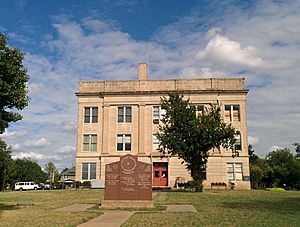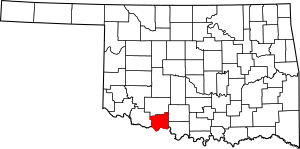Cotton County, Oklahoma facts for kids
Quick facts for kids
Cotton County
|
|
|---|---|

Cotton County Courthouse in September 2014
|
|

Location within the U.S. state of Oklahoma
|
|
 Oklahoma's location within the U.S. |
|
| Country | |
| State | |
| Founded | 1912 |
| Seat | Walters |
| Largest city | Walters |
| Area | |
| • Total | 642 sq mi (1,660 km2) |
| • Land | 633 sq mi (1,640 km2) |
| • Water | 9.3 sq mi (24 km2) 1.4%% |
| Population
(2020)
|
|
| • Total | 5,527 |
| • Density | 8.609/sq mi (3.3240/km2) |
| Time zone | UTC−6 (Central) |
| • Summer (DST) | UTC−5 (CDT) |
| Congressional district | 4th |
Cotton County is a county located in the state of Oklahoma. A county is a part of a state, like a smaller region with its own local government. In 2020, about 5,527 people lived here. The main town and county seat is Walters.
When Oklahoma became a state in 1907, this area was part of Comanche County. Cotton County was created in 1912. It was the very last county formed in Oklahoma. It got its name because cotton was the main crop grown here at that time. Cotton County is also part of the larger Lawton, Oklahoma metropolitan area.
Contents
History of Cotton County
The eastern part of what is now Cotton County was opened for new settlers in 1901. This happened through a lottery system called the Kiowa-Comanche-Apache Opening. In 1906, another area called the Big Pasture was opened. People could buy land there through a special bidding process. Most of this land became part of Comanche County when Oklahoma became a state in 1907.
In 1910, people living in this area tried to create a new county. They wanted to call it "Swanson County," but it didn't work out. Then, in 1912, they tried again, and this time they succeeded! They decided to separate from Comanche County. They named their new county "Cotton County" because cotton was the most important crop in the area.
At first, Randlett, Oklahoma was chosen as a temporary county seat. But after an election on November 4, 1912, Walters, Oklahoma became the permanent county seat.
Over time, the types of crops grown in the county changed. By 1915, wheat became more common than cotton. Corn was also grown a lot. By 1934, corn was less common, and winter wheat, cotton, and oats were the main crops.
The number of people living in Cotton County has generally gone down since 1920. In 1920, there were 16,679 people. The population briefly increased in the late 1900s, but it has been decreasing again in recent years.
Geography of Cotton County
Cotton County covers about 642 square miles. Most of this area, about 633 square miles, is land. The rest, about 9.3 square miles, is water.
The eastern part of the county is in a region called the Cross Timbers. This area has a mix of forests and grasslands. The creeks and streams in Cotton County flow southeast into the Red River. The Red River forms the southern border of the county.
Major highways
Adjacent counties
- Comanche County (north)
- Stephens County (northeast)
- Jefferson County (southeast)
- Clay County, Texas (south)
- Wichita County, Texas (southwest)
- Tillman County (west)
People in Cotton County
The number of people living in Cotton County has changed over the years. In 1920, there were over 16,000 people. By 2020, the population was 5,527.
In 2000, there were 6,614 people living in the county. About 84.7% of the people were White. About 7.4% were Native American, and 2.8% were Black or African American. About 4.8% of the population was Hispanic or Latino.
The average age of people in the county in 2000 was 39 years old. About 25% of the population was under 18 years old. About 18% of the population was 65 years or older.
The average income for a household in the county was about $27,210 in 2000. For families, the average income was about $35,129. Some families and individuals in the county had lower incomes.
Economy of Cotton County
The economy of Cotton County has always been focused on agriculture. This includes growing crops like cotton and wheat. It also includes raising livestock such as cattle and poultry (like chickens).
Starting in the late 1910s, the oil and gas industry also became important. By 1920, the county had many oil and gas wells. There were also oil refineries, pumping stations, and pipelines in the southern part of the county.
A large store called Temple's B & O Cash Store used to be in the county. It shipped goods all over the country. Later, it was bought by Sears and Roebuck but eventually closed in 1954.
In 1997, Cotton County had almost 70,000 cattle. It also ranked eleventh in Oklahoma for the number of poultry sold.
Communities
City
- Walters (county seat)
Towns
Unincorporated communities
Images for kids
See also
 In Spanish: Condado de Cotton para niños
In Spanish: Condado de Cotton para niños


